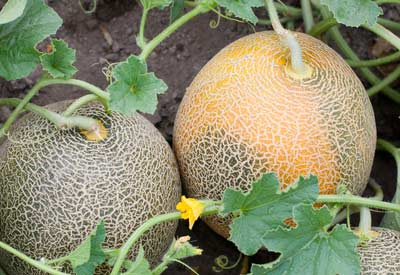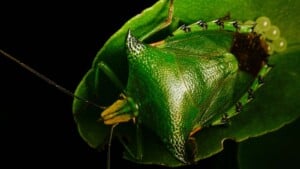After our last column, a friend pointed out that she didn’t have trouble getting melons to pollinate. Her problem was with blights and mildew. It’s true that melons are a bit difficult to grow because of their susceptibility to molds and certain insects, especially when you’re trying to grow them in cooler, damp climates. Any trouble growing melons is well worth it once they reach the table. The cantaloupes, watermelons and other melons now coming into our stores from warmer climates just don’t hold a candle to a juicy, sweet, homegrown melon.
Finding the proper natural or organic cures for these melon problems can be difficult. Mulching is great for issues caused by uneven watering. But mulch can provide places for pests including squash bugs and cucumber beetles to lay eggs. These pesky critters not only consume melon plants but spread disease and wilt. Melon leaves can be burned by insecticidal soap and liquid copper sprays, two common, organic-approved solutions for bugs and mildew. They should only be used in the most diluted form possible. Other problem solvers — like using row covers to shield plants from insects — are great ideas until you need the help of pollinators. Any successful melon growing regimen begins even before you start them in your garden.

FREE SHIPPING!
Ladybugs
This native ladybug species is the best known garden predator available.
Learn moreGot bugs? At Planet Natural we offer a large selection of organic pest control solutions that are guaranteed SAFE and effective. Also, visit our Pest Problem Solver for pest pictures, descriptions and a complete list of earth-friendly remedies.
I’ve moved around enough and started new gardens to know one thing is true: the first year is the easiest to grow melons. After that, problems start to mount. So the first rule, one especially helpful in avoiding blight and mildew, is to rotate your melon crop as best possible. Growing melons in warm dry areas of the country is easier than growing them where it’s cool and moist. Good drainage is important as well as is even, careful watering. Over watering gives molds and mildew encouragement they don’t need. Water at the base of plants as best you can and avoid getting leaves damp. Watering at the beginning of the day gives moisture time to evaporate off plants.
The cucumber beetle is your enemy. They’re fairly well distributed around the country, we’ve even spotted them — they’re kind of attractive — as far north as our Montana garden. The damage they do to leaves may be minimal but their role in spreading wilt can be disastrous. Use insect traps to detect their appearance in large melon patches. A good visual inspection every few days will suffice if you only have a plant or three. Avoid touching the leaves. You, like the beetle, are capable of spreading mold, wilt and other spores.
You can deter cucumber beetles from breeding by using black plastic as a mulch. This prevents the eggs from getting into the soil that they need to hatch and keeps the larvae from getting out of the ground. It also helps warm melon plants in the early season. If you have an infestation you may have little choice but to spray with a pyrethrin mix. Having gangs of preying mantis patrolling your melons may help you avoid getting to that point. Here’s a thorough discussion on organic control of cucumber beetles.

Aphids will also go after melon leaves and vines. Releasing ladybugs at the first site of them may help but could be too late if you have problems with mildew. Like beetles, aphids spread disease. With either aphids or beetle infestations, you can use a very weak insecticidal soap spray to take care of them. But make sure you dilute it almost to the point where it doesn’t feel soapy. And spray early in the day to allow it to evaporate before it gets hot.
What to do if you spot mildew, mosaic, blight or wilt? Applying copper spray is best but again requires dilution. If the problems have spread widely, there’s nothing to do but destroy the vines. Remove them carefully and stuff immediately into a bag so as not to spread spores or bacteria. Then take them far away from your garden. Burning them? Good idea, but only if it’s legal. And be sure to plant next year as far away from the affected area as you can get.











